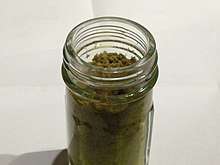Yuzukoshō
Yuzukoshō (柚子胡椒, also yuzugoshō) is a type of Japanese seasoning. It is a paste made from chili peppers, yuzu peel and salt, which is then allowed to ferment.[1] It is usually used as a condiment for nabemono dishes, miso soup, and sashimi. The most famous types of yuzukoshō come from Kyushu, where it is a local specialty.

Characteristics
The last pair of Han characters in the name, koshō, normally refers to black pepper; in the Kyushu dialect, however, it refers to chili peppers. Normally green chili peppers are used, but some versions use red peppers. Yuzukoshō made from green chilis is green, while using red chilis yields an orange paste.
History
Origin
There are theories that yuzukoshō was originally made in Hita, Ōita prefecture[2][3] and in Soeda, Fukuoka prefecture.[4]
One theory holds that several villages in Hita were the centers where yuzu cultivation became popular, and where yuzukoshō had been made by families for a long time.[2] Another holds that a garden in Mount Hiko, a mountain located between Fukuoka and Oita and one of the three sacred mountains of Japan, has a yuzu tree where yamabushi first created yuzukoshō. The process has been passed down through the generations of yamabushi.[4]
Popularity
Originally yuzukoshō was made by families, but mass-produced versions showed up on the market. It grew in popularity after being offered as a souvenir in the hot spring town of Yufuin Onsen. It grew even more in popularity when Fundokin (フンドーキン), a major producer of shoyu and miso in Kyushu, began making yuzukoshō. Recently it has become available in supermarkets in the Kanto region. In recent years, major producers like House Foods, S & B Foods, McCormick & Company, and Lion have started selling it. A version of yuzukoshō in a tube has appeared on the market. Tankankosho is a similar product using the more orange-like citrus tankan.
Use
Originally yuzukoshō was used in nabemono, but it is now also found as a condiment for Japanese meatball soup, udon, miso, sashimi, tempura, and Japanese grilled chicken. Further, since becoming available all throughout Japan, it is being used in various ways. For example, it is being used on spaghetti, salad dressing, tonkatsu, ramen, and shumai.
Large-scale manufacturers have also started using the flavoring in their products. Calbee makes snack foods such as potato chips that are flavored as yuzukoshō, but they are found in only certain locations. Ezaki Glico makes Pretz with the flavoring, and Meiji makes a curly corn chip that is sold only in Kyushu. Kameda makes fried mochi chips and senbei as well. However, as snacks must not have any moisture in them, the flavoring is created by combining yuzu powder and chili powder, and real yuzukoshō is not used. In Kyushu, Kit Kats with yuzukoshō flavor are sold.
See also
- Chili pepper paste
References
- Ono, Tadashi and Salat, Harris The Japanese Grill Random House, 2011, p. 7
- 大分放送大分百科事典刊行本部編『大分百科事典』1980年、大分放送発行
- 食は知恵なり-自然のちから- Archived October 9, 2012, at the Wayback Machine 日本テレビ、2008年3月10日
- 柚乃香 お店紹介 Archived December 22, 2015, at the Wayback Machine